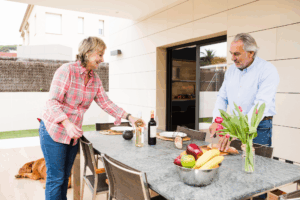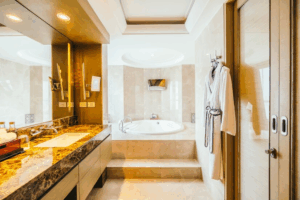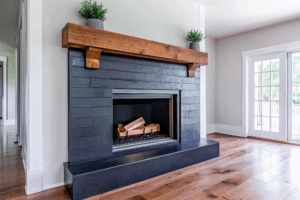
Outdoor kitchen countertops must withstand sun, rain, heat, and heavy use, maintaining their beauty and structure over time. That’s why the material you choose matters as much as the design itself.
Granite stands out as the ultimate surface for outdoor kitchen countertops. Its natural durability, resistance to weather, and timeless appeal make it ideal for spaces exposed to the elements.
Whether planning a full backyard renovation or upgrading a compact grilling area, granite offers performance without compromise.
This article explores why granite is the smartest investment for outdoor kitchen countertops, how to choose the right finish and tone, and what design factors you should consider.
Challenges of outdoor kitchen countertops in open environments
Designing an outdoor kitchen demands materials that can handle real exposure. While indoor surfaces are protected from climate changes, outdoor kitchen countertops must stand up to UV rays, heavy rain, sharp temperature shifts, and everyday wear.
Granite is one of the few materials naturally prepared for this level of demand. Formed under intense geological pressure, it has exceptional density and thermal stability. That means it doesn’t fade in the sun, crack with heat, or degrade when exposed to moisture.
External spaces tend to be more dynamic. Between grilling sessions, social gatherings, and daily prep, your countertops are subject to more movement, mess, and impact.
Granite’s surface resists scratches from knives and cookware, holds its edge against heavy use, and stays cool even under high outdoor temperatures. This performance sustains itself year after year with minimal upkeep.
However, durability isn’t the only concern. Outdoor kitchen countertops need to support a cohesive design that feels as intentional as the home interior.
With various color variations and textured finishes, granite allows for customization without sacrificing resilience. It works just as well in a contemporary patio kitchen as it does in a more rustic or traditional setting.
At Classic Stoneworks, we help you evaluate the stone’s technical qualities and how it will integrate with cabinetry, appliances, and surrounding architecture.
Granite outdoor kitchen countertops survive the elements and anchor the entire space with strength, elegance, and lasting performance.
Why granite is the ideal choice for outdoor kitchen countertops
Unlike engineered materials or softer stones, granite doesn’t fade in direct sunlight, doesn’t crack under high temperatures, and resists erosion from rain or coastal humidity. It maintains its structure and color even when exposed to the harshest seasonal changes.
For homeowners who value long-term performance, granite is a no-compromise solution. It’s available in dozens of colors, patterns, and finishes, from polished black to textured grays, making it easy to match any design style.
Low maintenance, high performanceOne of the greatest advantages of granite outdoor kitchen countertops is how little it demands from you. Once sealed, granite resists moisture penetration, staining, and mold.
You won’t have to worry about grease from the grill, wine spills during gatherings, or water pooling near the sink. Basic cleaning with mild soap and water keeps it looking polished. And because there are few seams compared to tiled surfaces, there’s less risk of buildup or degradation over time.
Natural beauty with design versatility
Granite is available in various tones, like deep charcoals, rich browns, lighter grays, and soft neutrals. Each slab carries its own unique pattern and mineral composition, offering visual depth without looking artificial or repetitive. Granite can be finished in polished, honed, or leathered textures to match the aesthetic.
Proven long-term value
Choosing granite is a smart investment that increases your property’s value and reflects a commitment to quality. It shows that your outdoor space was built to last, not just to impress. That permanence, visual and structural, is what makes granite a foundation.
Granite vs. Other materials for outdoor kitchen countertops

While there are several options on the market, not all of them are suited to the demands of exterior environments.
Here’s how granite stacks up against popular alternatives like quartz, porcelain, concrete, and wood, and why it remains the smartest choice for outdoor kitchen countertops:
- Granite
Granite offers excellent UV resistance, meaning it won’t fade or discolor when exposed to sunlight for extended periods of time.
Its high heat tolerance makes it perfect for areas near grills, cooktops, or fire pits. When properly sealed, granite also delivers strong stain resistance, handling food, wine, grease, and environmental residue with ease.
Because of its durability, stability, and visual impact, granite is highly recommended for outdoor kitchen countertops, especially in climates with strong sun, temperature swings, or seasonal moisture.
- Quartz
Quartz, while a popular choice for indoor kitchens, is not recommended for outdoor installations. It lacks UV stability, so exposure to sunlight causes yellowing, fading, or even warping over time.
Although quartz performs well indoors in terms of stain resistance and requires little maintenance, these benefits do not translate to outdoor environments, making it an impractical and risky investment for exterior spaces.
- Porcelain slabs
Porcelain is another strong contender. As a sintered material made for extreme durability, porcelain slabs offer excellent UV and heat resistance, plus a very low-maintenance surface that doesn’t require sealing.
It’s also resistant to stains, scratches, and moisture, making it a recommended option for modern outdoor kitchens. However, its thin profile may require additional substrate support depending on installation.
- Concrete
Concrete provides a bold, custom look, but its UV resistance is only fair, and prolonged sun exposure can lead to fading or surface breakdown. While it can withstand heat, concrete is prone to staining, and it demands medium-level maintenance, including sealing and cleaning.
For these reasons, concrete is suitable only in limited outdoor applications, and typically when a very specific design style is desired.
- Wood
Wood is rarely used for outdoor kitchen countertops due to its poor resistance to UV, moisture, and heat. It is high-maintenance, requires frequent sealing, and is vulnerable to warping, staining, and fading.
It can offer a warm, rustic feel, but it’s not a practical choice for permanent outdoor installations.
In short, granite remains the most balanced and trusted material for outdoor kitchen countertops, offering long-term beauty, functionality, and resilience.
- Choosing the right finish, color, and maintenance plan for granite outdoor kitchen countertops
Selecting the right granite involves making thoughtful decisions that align with performance, aesthetics, and usability in an outdoor environment. Finish, color, and care are essential in ensuring your outdoor kitchen countertops stay beautiful and functional year after year.
- Finish
In outdoor kitchens, the finish affects the look and resilience of the surface. Polished granite adds shine and depth and can be more reflective in direct sun and slightly more slippery when wet. For covered areas, it adds elegance and luminosity.
Honed or leathered finishes, on the other hand, offer a more matte texture that reduces glare and adds subtle tactility, ideal for open-air spaces and homeowners who want a more natural, relaxed feel. These finishes also help conceal smudges and fingerprints, making them a popular choice for busy outdoor setups.
- Color
Sun exposure can gradually affect the appearance of some materials, but granite is naturally UV-resistant. This means it holds its color over time. Still, color choice is essential.
Lighter shades like soft grays, taupe, or speckled neutrals tend to reflect heat, making surfaces more comfortable to touch in warmer months. Darker slabs create a bold contrast and anchor the space visually but may warm up under direct sun.
The key is to consider your space’s orientation, surrounding materials, and how much natural light the countertops will receive.
- Maintenance
Granite is low-maintenance, but not maintenance-free. A professional seal at installation helps protect the surface from moisture and staining. From there, annual resealing — especially uncovered kitchens — will keep your countertops protected against the elements.
Daily upkeep is simple: use mild soap, water, and a soft cloth. Avoid acidic or abrasive cleaners, as they can wear down the sealant.
With the right choices in finish and color, and a smart maintenance routine, your granite outdoor kitchen countertops will offer elegance and reliability for years to come.
- Specific care tips for granite in outdoor kitchen countertops
Choosing granite for your outdoor kitchen countertops means investing in a material that delivers resilience and low maintenance. However, to preserve its performance and beauty in high-use, weather-exposed environments, a few smart care habits go a long way.
- When to reseal: Try the water drop test
Granite is dense, but it’s still a natural stone with some porosity. That’s why sealing is essential, especially outdoors. To know when it’s time to reseal, use the simple water drop test:
- Drip a few drops of water onto the surface.
- If the water beads up and remains on the surface for more than 5 minutes, your seal is still holding.
- If the granite darkens or absorbs the water, it’s time to reseal.
For outdoor countertops with regular use, we recommend testing every 12 months and resealing as needed.
- Post-barbecue cleaning made simple
Grease, sauces, and charred residue are common after a cookout, but granite handles it effortlessly:
- Wipe down the surface with a soft cloth, warm water, and a pH-neutral soap.
- Avoid steel wool or abrasive sponges.
- Dry with a clean cloth to maintain the natural finish.
- If spills happen, clean them promptly to prevent temporary discoloration.
- What to avoid protecting your granite countertops
Granite is tough, but avoiding a few common mistakes ensures it stays in top form:
- Skip acidic cleaners like vinegar, lemon juice, or ammonia-based products, as they can break down the sealant.
- Don’t use abrasive pads or tools, which can scratch or dull the finish.
- Avoid leaving wet metal items on the surface, as they may cause rust stains.
Pro tip: Small habits extend countertop life
Use cutting boards for food prep. Granite resists cuts, but preserving the finish keeps it looking refined.
Use trivets or heat pads for hot pans and grills. While granite is heat-resistant, thermal shock can still affect the sealant over time.
Caring for your outdoor kitchen countertops doesn’t require complex routines, just thoughtful use. These simple habits help maintain the stone’s natural beauty and performance, so your space stays functional, elegant, and ready for every gathering.
- Elevate your outdoor space with the right granite countertops

The material is the foundation of how your outdoor space feels and performs, season after season.
Granite stands out for its durability, natural elegance, and low-maintenance nature. The right countertop enhances the experience and reflects the care you put into every detail of your home.
At Classic Stoneworks, we specialize in crafting outdoor kitchen countertops that are tailored to your climate, lifestyle, and vision. From slab selection to precision installation, our team guides each step, ensuring results that last.
Ready to upgrade your outdoor kitchen with granite?
Contact Classic Stoneworks today to schedule a consultation and discover the possibilities for your outdoor project.











